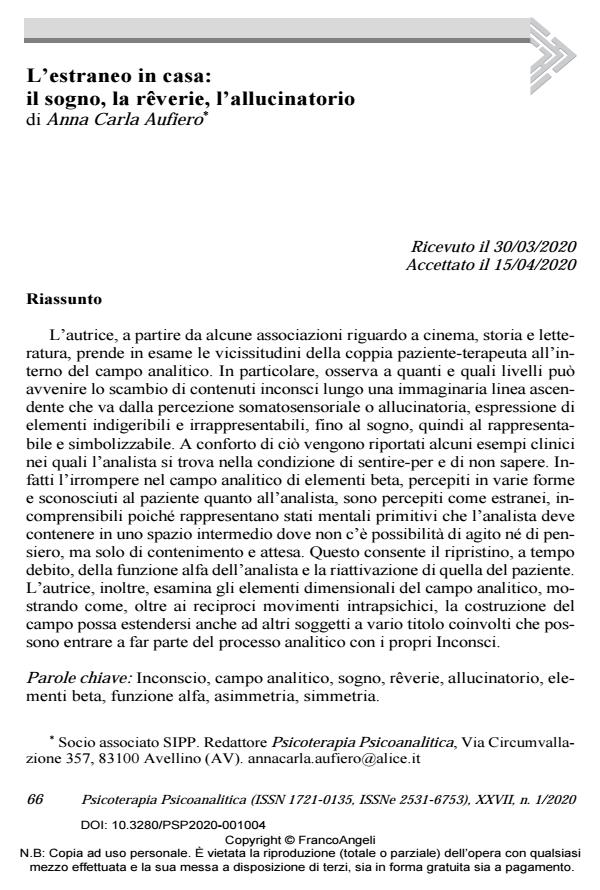A stranger in my home: dream, rêverie, hallucinatory perception
Journal title PSICOTERAPIA PSICOANALITICA
Author/s Anna Carla Aufiero
Publishing Year 2020 Issue 2020/1 Language Italian
Pages 23 P. 66-88 File size 230 KB
DOI 10.3280/PSP2020-001004
DOI is like a bar code for intellectual property: to have more infomation
click here
Below, you can see the article first page
If you want to buy this article in PDF format, you can do it, following the instructions to buy download credits

FrancoAngeli is member of Publishers International Linking Association, Inc (PILA), a not-for-profit association which run the CrossRef service enabling links to and from online scholarly content.
Inspired by her associations on cinema, history and literature, the Author examines the vicissitudes of the patient-analyst dyad in the analytic field. Particularly, she observes where and when an exchange of unconscious contents can take place along a virtual, ascending line which - starting from somatosensory or hallucinatory perceptions, i.e., the expression of undigested and unrepresented elements - flows into dreaming as a possibility to represent and symbolize. This thesis is ex-emplified by some clinical cases where the analyst "feels for" in a condition of "not knowing". In fact, beta elements - which irrupt into the analytic field under different forms and remain unknown to the pa-tient as well as to the analyst - produce a feeling of estrangement, be-cause they represent primitive mental states, which the analyst must contain within an intermediate area. In this area, neither action nor thinking is possible: containment and waiting are the only possible op-tions. In due time, this containment will foster recovery of the analyst’s alpha function and reactivation of the patient’s alpha function. The Author also explores the dimensional elements of the analytic field, indicating that field construction does not simply concern mutual intra-psychic processes, but it can expand to other subjects, for whatever reason involved, who can become part of the analytic process with their own unconscious contents.
Keywords: Unconscious, analytic field, dream, reverie, hallucinatory perception, beta elements, alpha function, asymmetry, symmetry.
- Bion W.R. (1962). Apprendere dall’esperienza. Roma: Armando, 2009.
- Bion W.R. (1967). Analisi degli schizofrenici e metodo psicoanalitico. Roma: Armando, 2009.
- Bollas C. (2009). Il mondo dell’oggetto evocativo. Roma: Astrolabio-Ubaldini, 2009.
- Botella C. e S. (2001). La raffigurabilità psichica. Roma: Borla, 2004.
- Chianese D. (1987). L’intervallo che precede la seduta: un vertice di osservazione sul “continuo-discreto” in analisi. In: Muratori A.M. (a cura di): Il «continuo» e il «discreto» in psicoanalisi. Roma: Borla, 1987, 95-105.
- Fellini F. (2015). Fare un film. Torino: Einaudi.
- Ferro A. (2014). Modello onirico della mente. In: Ferro A. (a cura di): Psicoanalisi oggi. Roma: Carocci.
- Freud S. (1899). L’interpretazione dei sogni. OSF, 3.
- Grotstein J.S. (2000). Chi è il sognatore che sogna il sogno? Uno studio sulle presenze psichiche. Roma: Edizioni Scientifiche Ma.Gi., 2004.
- Klein M. (1926). Principi psicologici dell’analisi infantile. In: Klein M., Scritti 1921-1958. Torino: Bollati Boringhieri, 1978, 149-161.
- Matte Blanco I. (1975). L’inconscio come insiemi infiniti – Saggio sulla bi-logica. Torino: Giulio Einaudi, 2000.
- Ogden T. (1997). Rêverie e interpretazione. Roma: Astrolabio-Ubaldini, 1999.
- Pessoa F. (1982). Il libro dell’inquietudine. Milano: Feltrinelli, 2012.
- Poe E.A. (1845). Racconti del terrore. Milano: Mondadori, 2017.
- Scoppola L. (2005). L’esperienza di essere sé. Milano: Franco Angeli.
- Scoppola L. (2011). La parola non trovata. Mente, corpo, istituzione. Milano: Franco Angeli.
- Voci senza corpo, corpi senza voce: Eco e Narciso ai tempi della post-modernità Anna Carla Aufiero, in PSICOTERAPIA PSICOANALITICA 1/2022 pp.114
DOI: 10.3280/PSP2022-001008
Anna Carla Aufiero, L’estraneo in casa: il sogno, la rêverie, l’allucinatorio in "PSICOTERAPIA PSICOANALITICA" 1/2020, pp 66-88, DOI: 10.3280/PSP2020-001004